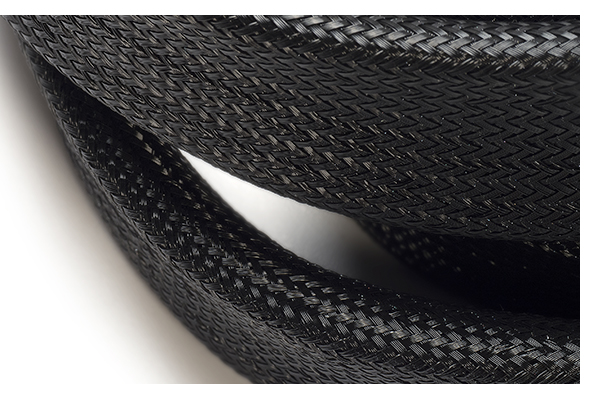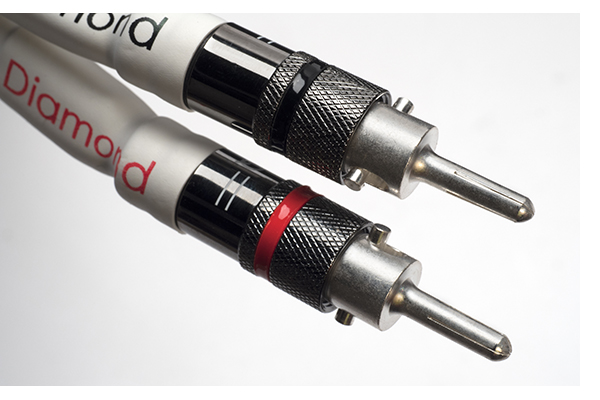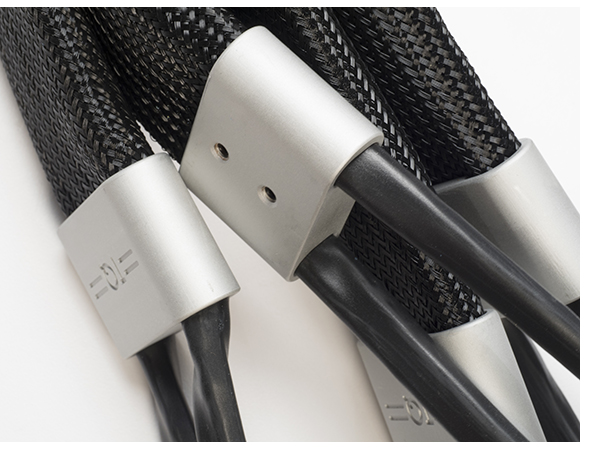Tellurium Q Silver Diamond Speaker Cables! These Diamonds Are an Audiophile’s Best Friend
By Jerold O'Brien Not having made changes to my system in a long time proves a double-edged sword; I know it intimately to the point where a minute change will be easily spotted and I was ripe to draw the cable review card.
Not having made changes to my system in a long time proves a double-edged sword; I know it intimately to the point where a minute change will be easily spotted and I was ripe to draw the cable review card.
A number of industry friends have been raving about Tellurium Q in person and out on the web, and this, too, is a double-edged sword because sometimes one wants desperately to believe the positive expectation.
The cables come packaged in a nice but not overly ostentatious box. Our review sample came equipped with locking banana connectors and a set of bi-wire jumpers similarly finished. Also enclosed is THE DISC, offering tracks chock full of randomly generated white noise, pink noise, pulses and sweep signals that go up and down the sonic spectrum. There are three tracks on the disc. Track one is a system check for proper phase, etc. Track two is an hour-long conditioning track which serves to not only condition the speaker cables but every other component in the chain. Track three is a ten-minute conditioning “warm up” to be played each time you decide to listen to your system.
By rights, I should hate these cables. I say that because it is silver-plated but that’s only the beginning of this product’s story. To make my personal bias clear, I have rarely heard solid silver cables that swept me off my feet, and silver-plated cables have always been tossed out of the system with great disdain since they sounded too horrible. You know the drill: overly etched, harsh, irritating, etc. Never completely musical. Well, now all that has changed. At least for this listener with this product.
Perusing the Tellurium Q website, I didn’t see a lot of detail regarding the exact construction, metal plating or dielectric materials used in these cables, but there is a lot of information regarding the process by which they arrive at their final design. Most of it has to do with combating phase distortion, which causes smearing of the musical signal. Within each cable, different geometries are employed, different dielectrics are used, and the plating is matte instead of shiny and has a specific thickness. This witches’ brew of manufacturing results in the product at hand. One interesting side note, the matte silver plating on the banana connectors is exactly the same as the input connectors on my speakers.
 After installing the cables carefully, with attention to phase, the provided jumpers serving to ensure signal continuity between the low and high inputs, I followed up with the hour-long track of the test disc to make sure I was completely set up. Immediately, the greater sense of depth and width presented by my reference components exceeded that of what I was previously experiencing. This is not a subtle change, it is more like someone opened a huge door at the back of the room that I hadn’t known was there, causing me to immediately relax and enjoy what followed. So much for user bias. Vigilance to find that harsh-etched sound that silver always gave me, but it simply isn’t there with the Silver Diamond speaker cables. The overall high frequency character is presented in an utterly clear but completely musical fashion. This, added to the sense of space I mentioned earlier, combined with exacting bass extension and definition makes for a thoroughly enjoyable session. It doesn’t matter whether I play symphonic music with massed violins or bass and drum jams, the result is always the same…..simply music.
After installing the cables carefully, with attention to phase, the provided jumpers serving to ensure signal continuity between the low and high inputs, I followed up with the hour-long track of the test disc to make sure I was completely set up. Immediately, the greater sense of depth and width presented by my reference components exceeded that of what I was previously experiencing. This is not a subtle change, it is more like someone opened a huge door at the back of the room that I hadn’t known was there, causing me to immediately relax and enjoy what followed. So much for user bias. Vigilance to find that harsh-etched sound that silver always gave me, but it simply isn’t there with the Silver Diamond speaker cables. The overall high frequency character is presented in an utterly clear but completely musical fashion. This, added to the sense of space I mentioned earlier, combined with exacting bass extension and definition makes for a thoroughly enjoyable session. It doesn’t matter whether I play symphonic music with massed violins or bass and drum jams, the result is always the same…..simply music.
Enough time has passed now that I continue to be amazed at the positive change the Tellurium Q speaker cables have made to my system – so much so that our publisher had to literally pry them out of my system to get them back! I think we both are anticipating a full system review of their cables at a future point. We’ll keep you posted.
Further Listening – Jeff Dorgay
Our staff curmudgeon Mr. O’Brien is rarely, if ever, impressed with cables of any kind, and that’s not to say he’s anyone that mighty, it’s just his mindset. He’d rather talk to you for hours about the intricacies of setting the mechanical fuel injection on a BMW 2002tii than entertaining the thought that a piece of wire could make that much of a difference, but that’s the wide range of attitudes that makes the wheel go ’round here at TONEAudio.
Being that he is as excited as he is about these cables, I wanted to get them back ASAP to run them through their paces here, on a wide variety of speaker setups to see, or rather hear what I could hear. I would also like to give a nod of appreciation to Stuart Smith of HiFi Pig for not only telling me about these, but keeping on me until we got a set in for review.
Though a bit more open-minded to the cable thing than Jerold, I still stick to what I know for the most part, using Cardas Clear, Clear Light and now Clear Reflection in my two main systems, and Nordost Frey in system three. We can argue till the cows come home about this, but at least you know what I like and use on a daily. And I too bristle at the thought of silver-coated copper (for that matter, anything coated over anything else) cables, but we have to try and maintain some objectivity in this wacky world of high-end audio.
As Jerold mentions, there isn’t much specific “tech” on the Tellurium Q website, but director Geoff Merrigan makes it a point that his cables are designed to preserve the phase relationships in the audio signal. While I am not remotely qualified to comment on this, I do know that every speaker I have heard with the same engineering goal has always sounded the most natural to my ears, so I think Mr. Merrigan is indeed on to something.
I too have not changed anything in my reference system one for quite some time so it was easy to ramp up on a trial of the Tellurium Q speaker cables. I must admit, it was an
“oh wow” moment when plugging them in to the Quad 2812s. These speakers, in concert with the Pass Xs300 monos throw such a massive soundstage already, and resolve fine detail so well, anything good or bad is instantly brought to bear. So I ran the hour long break-in track and went for a coffee. This done, the delta was much wider. Rather than bore you with a barrage of audiophile clichés, the Tellurium Q cables paint a more vivid picture than what I was listening to before.
If you’re looking for a major jump in your system’s performance, I’d suggest buying a pair of these instead of considering a hardware upgrade. Before you write this advice off to cable delusion, expectation bias, or the recent Mercury retrograde phase, please take note: I have never said this in TONE’s 11-year history. There are a number of times I’ve swapped a good $5,000 preamplifier or DAC for a good $10,000 unit and not had this level of increased musical involvement.
Every aspect of my system’s presentation is improved; the soundstage grows markedly in every direction, transients are faster and cleaner, with a quieter overall presentation. The comment that everyone else hearing these cables, with no idea what they are or what they cost, said the same two things: “it sounds bigger,” and “it sounds louder.” I didn’t expect how much smoother, yet more resolving, everything sounds. I’ve never heard the Quads sound this enveloping.
$7,500 is a lot of money for wire, but the Tellurium Q Silver Diamond Cables deliver the goods. In the context of a six-figure system, this is merely a punctuation mark and the well-heeled customer won’t even blink. However, even in a much more modest system consisting of a Prima Luna integrated, Simaudio CD player and the Rogers LS5/9s, with a $10k price tag total, these cables still provide a dramatic enough improvement to be worth the price asked. In every possible system configuration I could scratch together, the results are the same.
Value is a highly relative subject; cable is nearly always a hotspot and I admit to being more prejudiced against spending big money on it, yet the Tellurium Q Silver Diamond speaker cables deliver more music than anything I’ve yet experienced. I highly suggest auditioning them the next time you’re considering spending some money on a system upgrade.
Produced and distributed in the UK, these cables are more readily available in the rest of the world. Walter Swanborn at Fidelis AV in the US is the sole outlet for now, but he’s an affable and easy guy to find. I guarantee you’ll be surprised!
The Tellurium Q Silver Diamond Speaker Cables
$7,500 (2m pair)
www.telluriumq.com (manufacturer)
www.fidelisav.com (US outlet)




